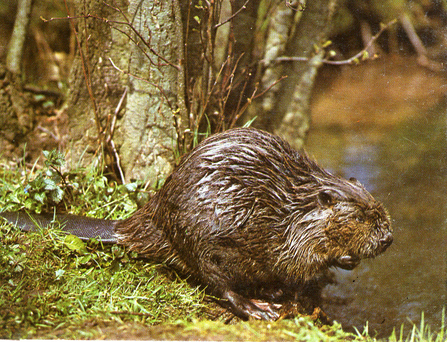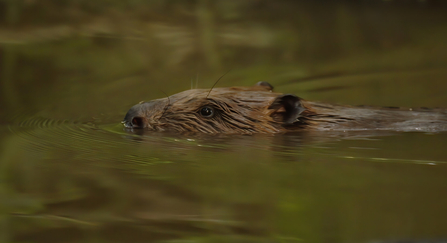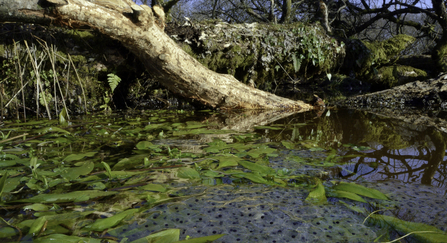Beaver basics
Get to know nature's best builder
What do beavers look like?
The Eurasian beaver (Castor fiber) is a large herbivore, a mammal that is native to Britain and was once widespread. They have a broad, flat tail, as well as strongly webbed hind feet. Their dense fur (the second most dense in the animal kingdom after otters) is usually brown but can sometimes be black. They have small eyes and large, bright orange front teeth (from an iron-based enamel coating).
In the water, beavers could be confused with otters. However, otters are more sleek in appearance and have long, rounded tails covered in fur.

Do beavers eat fish?
No. Beavers are vegetarian and eat a wide variety of plants. In summer, they prefer pond weeds, grasses and leaves. In winter, they eat the bark of trees, favouring willows and poplars. They also cache food on the bottom of the watercourse near their lodge in the winter or in harsh environments.
You said beavers are a native species, so where did they go?
Beavers were common until the species was hunted to extinction in the 16th century for its fur, meat and scent glands used in perfume making. The loss of this charismatic species also led to loss of the mosaic of lakes, meres, mires, tarns and boggy places that it so brilliantly built. Since they've been reintroduced, there are now beaver enclosures all over Britain, and several wild populations in and around Devon, Kent and Somerset as well as numerous Scottish catchments.
Why do beavers build dams?
Beavers like consistent water levels to keep them (especially their kits) safe from predators. They achieve this by building dams which create deep areas of water where they can create protected, underwater entrances to their lodges and burrows. This all means they're safe from their natural predators.
How easy is it to spot a beaver?
Beavers are nocturnal so are most active and visible during dusk and dawn. It's easiest to capture a good sighting of a beaver during the spring and summer months when they emerge before darkness falls.
Do beavers have any legal protection?
Beavers are now listed in Schedule 2 of the Conservation of Habitats and Species Regulations 2017, making it an offence to deliberately capture, injure, kill or disturb beavers, or damage and destroy their breeding sites or resting places. This follows Scotland’s decision to make beavers a protected species in 2019.
How long do beavers live for in the wild?
Their average lifespan is seven to eight years, but can be up to 25 years.
How much space do beavers need?
A beaver's territory size varies with habitat, density and season. Generally 3km2 is the amount of space two adults need, but this can vary with a minimum amount of 0.5km2 for one individual.
How quickly do beavers breed?
On average, beavers breed once a year and produce an average of three young (kits). Once territories are established, population numbers only rise slowly. Beavers live in strict family groups, with only the dominant pair breeding.
Do beavers have any predators here in Britain?
Beaver kits are vulnerable to predation by foxes, birds of prey and potentially otters – so not all the young will survive. This is quite normal in wild animals with species from swans to beavers to hares all producing multiple young. As some of the young are likely to die from causes such as predation, disease, natural causes or lack of food, for example, having multiple young increases the likelihood that at least one of the offspring will survive to adulthood to carry on the genetics of the parents.
How likely are beavers and otters to interact? What will their relationship be like?
As both species are native to Britain, beavers and otters will have evolved to coexist. They have very different diets, with beavers being vegetarian and otters being apex predators, so they do not need to compete for food. It is also likely that otters will benefit from the beavers' ecosystem engineering activities that create complex wetland systems full of food, as well the occasional discarded den site. However, otters are carnivores and need to hunt to survive and feed their own young. If the opportunity arose it is possible they would take a young beaver, as has been reported in Scotland recently, but this is not seen as a threat to their reintroduction, as opposed to nature just taking its course.

Russell Savory
Beaver benefits
How will having beavers in Gloucestershire benefit us?
How do beavers help reduce the impacts of flooding?
Beavers help to slow the flow of water passing through the rivers and streams where they create channels, dams and wetland habitats, as these hold back water and release it at a slower rate. This in turn reduces the impacts of flooding downstream.
How do beavers help other wildlife?
As ecosystem engineers, beavers make changes to their habitats, such as coppicing trees and shrub species, damming smaller water courses, and digging 'beaver canal' systems. These activities create diverse and dynamic wetlands - helping to reconnect floodplains with their watercourses. In turn, these wetlands can bring enormous benefits to other species, such as otters, water shrews, water voles, birds (like kingfishers), invertebrates (especially dragonflies) and breeding fish.

Devon Beaver Project, Devon Wildlife Trust
Why are beavers so important?
Beavers are a 'keystone species' and 'ecosystem engineers'.
'Keystone species' are species that drastically impact and define ecosystems in a positive way. Without them the ecosystem they live within would be very different.
'Ecosystem engineers' are species that make changes to their habitats in a positive way, and create new habitats within the ecosystem they live in.

(c) Nick Upton Cornwall Wildlife Trust
Beaver feasibility study
All about the proposed beaver feasibility work
What is a feasibility study?
A study that assesses the viability of an idea (in this case wild-living beavers in Gloucestershire) carried out by conducting biological, ecological, social and legal studies. In this proposed feasibility study we would also facilitate the formation of a Gloucestershire-wide stakeholder partnership to ascertain levels of support and collate information on concerns.
What are the biological and ecological studies in this feasibility plan?
We will need to assess the viability of any potential beaver release site, including habitat availability and connectivity, population dynamics, core resource requirements, causes of non-natural mortality, disease risk and genetics. This will not only establish where releases could take place and the multiple benefits that could be generated, but also which areas should be avoided. It will also identify additional habitat creation work required to establish self-sustaining wild populations or to steer beavers away from areas.
We will consider potential impacts on the ecosystem and existing species, including potential ecological benefits and disbenefits and produce an ecological risk assessment. This assessment will also provide a series of recommendations and/or critical success factors which need to be considered for suitable areas to progress to the next stage.
Different methods and techniques are used to see how suitable a location is for a species reintroduction. We will ground-truth areas that have been identified using GIS mapping at potential sites. Both of these methods look at size of an area in relation to the beavers home range and the density of beavers an area could hold. Along with studying the habitat quality, density and suitability of habitat for beavers .
What are the social and legal studies used in this feasibility plan?
Social feasibility will consider social, economic and political factors integral to translocation feasibility and design. To study the social aspect of the reintroduction of the beaver to Gloucestershire, landowners and communities that fall within the mapped potential areas will be engaged with and consulted on the project.
A key aspect of the project is the formation of a Gloucestershire beaver stakeholder partnership. Reaching out and building relationships with key landowners in areas where beavers may have an impact is vital. We are working with representatives from the National Farmers’ Union and other stakeholders to understand and pre-emptively address any concerns around free-living beavers, including discussions around management and mitigation as well as around benefits and myths.
Will I be able to see the results of this beaver feasibility study?
The results of the feasibility study will be made publicly available on completion to enable the most effective and open presentation and implementation of the findings.
What's the risk of my land flooding from beavers being reintroduced?
Beavers are known for their dam-building, but they will only do so in certain circumstances, and there are well-tested measures that can be taken to manage or mitigate unwanted effects where they occur. Using tools such as the University of Exeter’s Beaver Dam Capacity model, the feasibility study aims to identify where beaver activity might cause unacceptable flooding, and how this might be avoided. Any future wild-release proposal would require a full consultation, in accordance with Defra/IUCN translocation guidelines.
If the project is being co-funded by Forestry England does that mean it will only focus on the Forest of Dean?
No, the study will look at feasibility across Gloucestershire. Forestry England are interested to learn more about how beavers could restore ecosystem functioning on their land in the west of the county, but the remit of the feasibility study and GWT's interest is much wider than that.
What is the current legal position in England when it comes to beaver reintroductions?
In England a licence is required to possess and release beavers into enclosures and although a licence has been granted for a free-living beaver population on the River Otter in Devon, and other breeding populations exist elsewhere, no other licences are currently being issued for direct releases into the wild while Natural England and DEFRA consider the detail of a forward policy for the species. A public consultation on the proposals to allow beaver releases into the wild, where licence applications show clear benefits and where risks of negative impacts are avoided, mitigated for or managed, closed in November 2021 but a formal government response has yet to be published.
Your appeal talks about reintroducing beavers to Gloucestershire, but aren’t there already beavers in the Forest of Dean and Cotswold Water Park?
There have been fenced reintroductions into the county, including at Greathough Brook in the Forest of Dean and Cotswold Water Park. However, this feasibility study will be looking into whether wild releases are possible within Gloucestershire. More information on the Greathough beavers can be found on Forestry England's website.
What is the current legal position in England when it comes to beaver reintroductions?
In February 2025, the government announced a new licensing framework enabling the release of beavers into the wild in England. This framework includes guidelines for applicants wishing to reintroduce beavers into specified river systems, and requires that the impacts of beaver be considered at a catchment scale. It also includes a requirement to consult with local stakeholders. Natural England’s licensing team will be responsible for approving or denying licence applications, and it is thought that a limited number of licences will be approved in any one year to enable a gradual, managed restoration of the species.

David Parkyn - David Parkyn/ Cornwall Wildlife Trust
